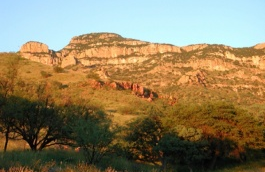An Eagle’s Nest Above the Borderlands
 by Matthew J. Nelson
by Matthew J. Nelson
For those who love the diverse and dramatic topography of the borderlands, and who are interested in spotting species like jaguars and elegant trogons, there are few places that offer a Sonoran Desert experience like the Atascosa Mountains southwest of Tumacacori.
Wandering among canyons, cliffs and grasslands is always an option, but a premier hike in this remote mountain range will take you to the site of a historic fire lookout with unforgettable views. The hike itself is a straightforward march to the summit – 2.5 miles and 1,500 feet of elevation gain. It’s steady, but not too steep. Along the way you’ll share the trail with a diverse mix of grasses, cacti, shrubs and trees as you walk through semi-desert grassland and oak-juniper biomes. It’s hard to make quick progress as you’ll feel inspired to stare out across the ever-expanding landscape.
After less than two hours you’ll arrive at Atascosa Lookout, a fire tower built in the 1930s by the Civilian Conservation Corps that was unfortunately destroyed by fire last summer. Even though the lookout has always been the destination, the purpose of the hike is the panorama. I’d go so far as to say that you won’t find a better view anywhere in Southern Arizona.
Virtually every mountain range can be seen from here. The Baboquivari Mountains dominate the western skyline, with Baboquivari Peak rising like a shield protecting the Tohono O’odham Nation. To the south the land ripples like an accordion, being squeezed and pulled apart as the Earth’s tectonic plates play a Norteño tune. The numerous ranges of Sonora can be seen from here, and some say that on a clear day you can see the volcanoes of the Sierra Pinacate to the southwest. Just beyond is the Sea of Cortez.
Atascosa Lookout was once home to the great Southwestern writer Edward Abbey, famous for classics such as “The Monkey Wrench Gang” and “Desert Solitaire.” About his seasonal retreat, Abbey wrote, “This lookout is merely a flimsy old frame shack perched like an eagle’s nest on a pinnacle of rock 6,235 feet high.”
Sunrise on Atascosa Lookout is epic, as it’s the time of day when the rocks really come to life. You’ll have to ascend by moonlight or headlamp if you want to catch the colors from the top. And you’ll know what Abbey meant when he wrote in 1968, “…woke up this morning on an island in the sky, surrounded by clouds. Wild swirling banks of vapor, flowing and passing to reveal brief glimpses of rocky crags, dripping trees, the golden grassy hillsides far below.”
No matter when you go or how long you stay, plan on spending some time in silence, just staring out across the borderlands.
Making Your Escape
From Tucson, drive south on I-19 toward Nogales, take the Ruby Road exit where you will see Forest Service signs for Peña Blanca Lake (exit 12). Turn right and follow the road west for nine miles. At the turnoff to Peña Blanca Recreation Area, the pavement ends and becomes the Arivaca-Ruby Road (Forest Road 39). Continue west for five miles and look for a small parking area on the south side of the road. There is a lone oak tree here, and if you look directly north from the parking area you’ll see a single brown trail marker. It’s easy to miss.
Local Conservation
Atascosa Lookout is part of the Tumacacori Highlands, a biologically significant zone that links the mountains and canyons of Sonora with Arizona. Jaguars have been spotted here, in addition to trogons, coatimundis and other exotic species. Sky Island Alliance has been working hard to rally support on a local and national level to promote the conservation of this area. Check out SkyIslandAlliance.org for more information.
Category: RECREATION




